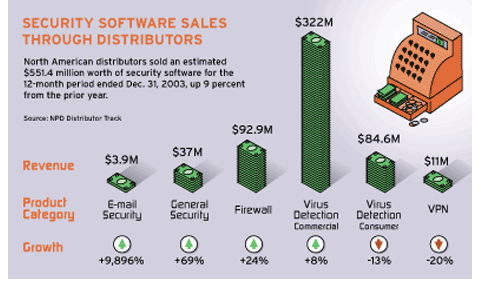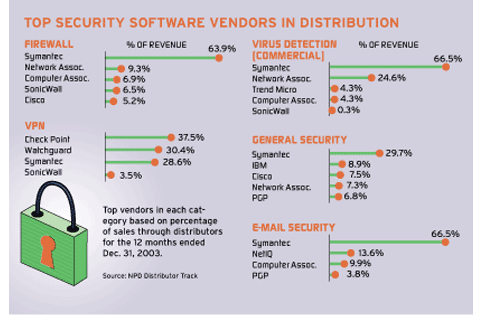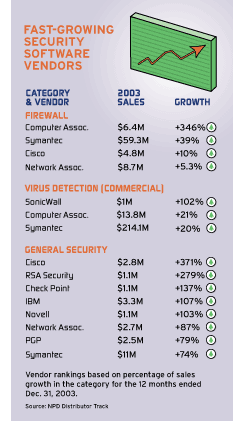Security Software
Editor's note: This is the first of four Distribution Snapshot special reports based on U.S. sales-out data reported by Global Technology Distribution Council members to the NPD Group research firm.
Security software is accounting for an ever-larger portion of distributor software sales, providing yet another indication that the security market is not only growing, but broadening to embrace a wider channel. Members of the Global Technology Distribution Council sold $551.4 million worth of security software in the U.S. channel last year, up 9 percent over the prior year. That was particularly impressive considering overall distributor software sales fell 9 percent to $4.58 billion in 2003.
The GTDC numbers do not include security software bundled with hardware, a trend that is impacting several categories, particularly consumer virus detection, which fell 13 percent to $84.6 million.
"Retail sales of stand-alone products are flattening because OEMs such as IBM and HP are integrating the client of security software into PCs when they go out the door," said Joe Serra, vice president of software and systems product marketing at Tech Data, Clearwater, Fla.

\
But that was more than made up for in the growth of commercial virus detection, firewall and general security software, the last of which grew a robust 69 percent and includes such applications as intrusion detection and identity management.
Distributors are clearly moving uptown, playing a larger role in handling complex and higher-end security software in competition with direct and single-tier transactions, distribution executives said.
| AD | |
|---|---|
| id | unit-1659132512259 |
| type | Sponsored post |
"More complex sales and larger implementations required to install particular applications favor more of a direct model. That's true of security or anything else," said Will Sumners, vice president of enterprise solutions at GE Access, Westminster, Colo. But he said security software developers know that the channel is an important tool to reach the midmarket and small businesses.
"Security software vendors are probably more adaptable to that [two-tier] approach than some of the bigger applications," he said. "We're now seeing a lot of growth in the midmarket space, the remote-office space and the home-office space. As an enterprise wanting to protect all three, it's cheaper to implement and understand one vendor's products to solve similar problems than to characterize them individually."
While the channel has proved to be the most effective way to sell those complete security solutions, distributors say they have proved they can manage complex licensing programs while extending credit and providing other levels of support.
"There's a staying power of software security within distribution," Serra said. "There were folks that thought distribution didn't have a role down that road. That's certainly proven not to be the case."
Ingram Micro expects double-digit growth in security software this year. The majority of Ingram Micro solution providers sell antivirus solutions, but many want to expand their security portfolio, said Lori Snow, vice president of category management at Ingram Micro, Santa Ana, Calif.
Snow said the distributor plans to enhance reseller education programs to focus on the higher end and the latest security solutions. "Antivirus, that's where you see their growth, but developers are expanding into other areas," she said.
In contrast to declining sales of consumer virus detection software, sales of commercial virus detection software rose 8 percent to $322 million. It represented the single-largest category for distributors, accounting for 60 percent of security software sales.
Firewall software was a distant second, accounting for $92.9 million, up 24 percent from the prior year, despite an intrusion by firewall appliances into the turf. "Firewalls continue to be very, very strong. People keep thinking the market is saturated," Sumners said.

\
VPN software sales, meanwhile, suffered the biggest drop, declining 20 percent to $11 million. "VPN continues to do well, but the sale of VPN has flattened out," Serra said. "We dove in to figure out what was happening, and what's happening is the firewalls are incorporating the VPN piece now. You're seeing the technologies come together."
The fastest-growing area,the spam- and compliance-driven e-mail security software category,grew a whopping 9,896 percent, but it was also the smallest category, accounting for $3.9 million in sales. Because of its high growth, the GTDC broke out the category for the first time last year.
Other emerging or still-niche areas in distribution are also growing quickly but are not yet broken out in the sales-tracking numbers. General security software, including intrusion detection, identity management, encryption and other SKUs, grew a strong 69 percent to $37 million last year.
One driving force was Symantec, which was clearly the distribution channel's favorite, coming out as the No. 1 vendor in every category except VPNs, where Check Point Software Technologies was tops. Symantec accounted for $11 million, or 29.7 percent, of distributor sales in the general security software category, up 74 percent from the prior year.
"They have a suite that has antivirus, intrusion detection, firewall and the ability to manage all those. It makes it a compelling solution," Serra said. "And they've done a fantastic job engaging with the channel."
Distributors expect that the trend toward integrated suites and solution providers' desire to sell more complete solutions will continue to drive the general security software category. "You can't have one layer to protect it all. You need firewall, intrusion detection and antivirus to make sure you're not violated," Sumners said.

While the GTDC numbers reflect only sales of software licenses and packaged software through GTDC members, distributors also see that combination of hardware and software as a growing source of revenue. Another key driver in the security arena has been a trend by developers to bundle their products into a solution that includes monitoring and management services, often with appliances or other hardware.
"Appliances are really getting traction right now," Serra said. "Just about all the vendors have them today. The combination of appliance and the software, that's the soup to nuts, that's where the traction is coming from."
If solution providers are trying to figure out where to create a niche, intrusion detection will be a good area to start because an increasing number of hacks are coming from unauthorized employees, said Kevin Schoonover, director of engineering for Arrow Electronics' Enterprise Storage Solutions division.
He said solution providers can also make a good business out of monitoring their customer's data.
"A lot of upper-end enterprise resellers we deal with are focusing more efforts on identity management, access management and intrusion [detection] that require more knowledge than a standard firewall," Schoonover said. "We have resellers who have customers that bought product, installed [it] and never got it running efficiently. The resellers are the guys looking more at tools to do auditing and vulnerability [assessment] %85 We see more value-add out of that."
Schoonover said opportunities abound, but many server-centric solution providers are not effectively selling security. "There's still a lot of education that has to happen in terms of understanding security and how breaches work and how vendors' products approach that," he said.
Distributors, however, are counting on more solution providers gaining that training and expanding their security businesses.
The 12-member GTDC includes eight U.S. distributors: Agilysys, Ingram Micro, Arrow Electronics, Avnet, Bell Microproducts, Synnex, GE Access and Tech Data.